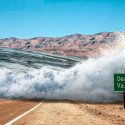What if all the Earth’s land became ocean, and all the oceans became land? And what if our mountains turned into deep trenches, while the trenches grew to the highest peaks on the planet?
What would this new world look like? Where, on this sprawling landmass, would humanity live?
And why would this planet have such a hard time sustaining life? Of course, with the volume of water in Earth’s oceans, inverting our topography would mostly look like we flooded the planet.
But where’s fun in that? Let’s eliminate some of the world’s water, so that the seven continents become oceans; and the seabed becomes one big, interconnected landmass.
Challenger Deep, once the deepest point in Earth’s oceans, would rise to become “Mount Challenger.” It’s fun to think about, but what if I told you that a world like this would have one major design flaw?
As far as we know, the ocean floor is pretty boring, topographically speaking. By and large, it’s mostly a vast plain at an average depth of 3,700 m (12,100 ft) below sea level.
That means, except for the Mariana Mountain Range, our upside-down world would be a huge plateau. And it would be well above the sea level we’re used to.
The thing is, the human body doesn’t handle high altitudes well. Most of us live around 840 m (2,700 ft) above sea level. Our inverted continent would be more than four times higher than that.
There would be less air pressure, and less air, too. We’d have to adapt to living in a low-oxygen environment if we wanted to survive. But that’s just the beginning of our problems.
An inverted Earth would be barely covered with water. The Himalayan Trench would turn out deep, but the rest of the seabed wouldn’t.
We’d be left with four shallow oceans, and one vast, neverending continent. On the bright side, you’d be able to walk to any part of the world. But with little oceans left, you probably wouldn’t want to go too far inland anyway.
Right now 71% of the Earth’s surface is covered with water. The surface of an inverted Earth would only be 29% submerged.
Oceans control our climate, distributing the heat from the Sun evenly throughout the planet. Less water surface would mean less evaporation and precipitation. As a result – most of the land would become a scorching desert, too hot and waterless for humans to survive.
You’d want to live close to the oceans, away from the unbearable temperatures of the hot land. But you might not stay there too long, either.
With so little water, oceans wouldn’t absorb enough carbon dioxide. Greenhouse gases would build up, and stay in the atmosphere; slowly cooking the planet. Life on Earth might resemble life on Venus.
There would be no fresh water left to drink. All the plants would die, and all the animals would follow shortly after. Humans could build a shelter to hide from unbearable heat, but food would be scarce. It would be hard to figure out how to preserve the existent life in such conditions.
But could life have emerged on an inverted Earth? Theoretically, yes. And it would also have transitioned to land much earlier. There simply wouldn’t be enough real estate at the bottom of the ocean.
If that evolutionary cycle led all the way to Homo sapiens, human anatomy would be very different. Maybe we’d evolve to be cold-blooded; to be able to take on the high temperatures of our inverted planet.
Subscribe to What-If on Youtube or follow the show on Facebook Watch.
Sources
- “Inverted Earth”. 2012. Imgur. Accessed December 15 2018.
- “What Would Earth Be Like If All The Land Was Oceans And All The Oceans Were Land?”. Gupta, Harsh, 2016. Science ABC. Accessed December 15 2018.
- “What Role Does The Ocean Play In The Weather?”. 2018. oceanservice.noaa.gov. Accessed December 15 2018.
- “If There Was A Majority Of Land On Earth (66 Percent Land), How Would It Affect The Animals And Plant?”. worldbuilding.stackexchange.com Accessed December 15 2018.
- “Effects Of High Altitude On Humans”. 2018. en.wikipedia.org. Accessed December 15 2018.




























Cool,hope to see more from you soon!Also,can u add more to the “what if among us happens irl”